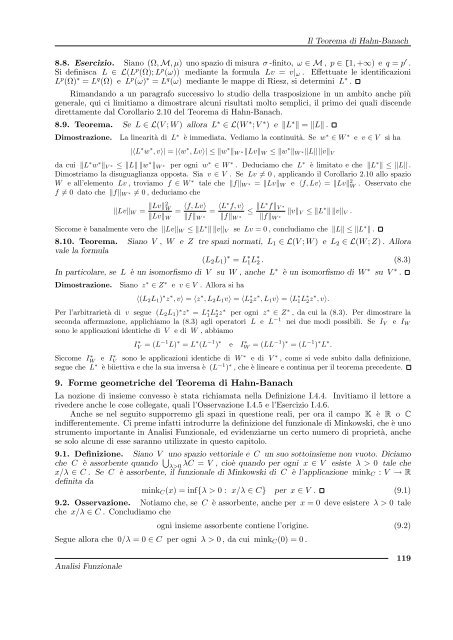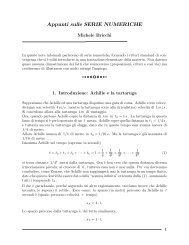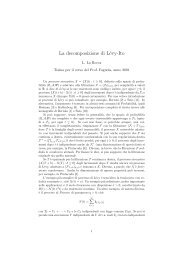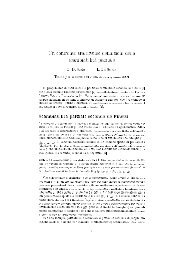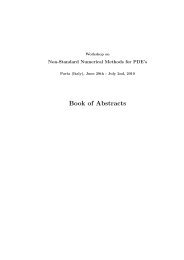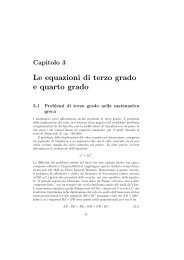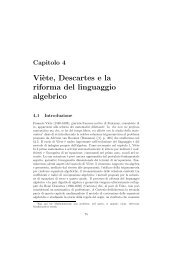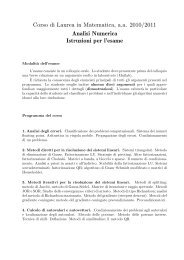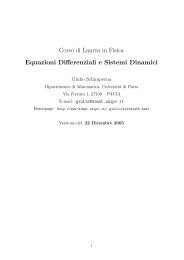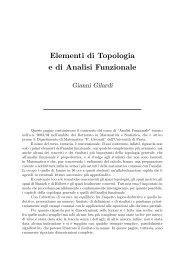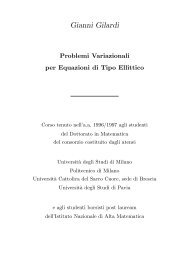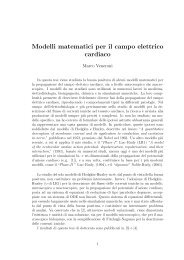G. Gilardi, Analisi Funzionale - Dipartimento di Matematica
G. Gilardi, Analisi Funzionale - Dipartimento di Matematica
G. Gilardi, Analisi Funzionale - Dipartimento di Matematica
You also want an ePaper? Increase the reach of your titles
YUMPU automatically turns print PDFs into web optimized ePapers that Google loves.
Il Teorema <strong>di</strong> Hahn-Banach<br />
8.8. Esercizio. Siano (Ω, M, µ) uno spazio <strong>di</strong> misura σ -finito, ω ∈ M , p ∈ [1, +∞) e q = p ′ .<br />
Si definisca L ∈ L(L p (Ω); L p (ω)) me<strong>di</strong>ante la formula Lv = v|ω . Effettuate le identificazioni<br />
L p (Ω) ∗ = L q (Ω) e L p (ω) ∗ = L q (ω) me<strong>di</strong>ante le mappe <strong>di</strong> Riesz, si determini L ∗ .<br />
Rimandando a un paragrafo successivo lo stu<strong>di</strong>o della trasposizione in un ambito anche più<br />
generale, qui ci limitiamo a <strong>di</strong>mostrare alcuni risultati molto semplici, il primo dei quali <strong>di</strong>scende<br />
<strong>di</strong>rettamente dal Corollario 2.10 del Teorema <strong>di</strong> Hahn-Banach.<br />
8.9. Teorema. Se L ∈ L(V ; W ) allora L ∗ ∈ L(W ∗ ; V ∗ ) e �L ∗ � = �L� .<br />
Dimostrazione. La linearità <strong>di</strong> L ∗ è imme<strong>di</strong>ata. Ve<strong>di</strong>amo la continuità. Se w ∗ ∈ W ∗ e v ∈ V si ha<br />
|〈L ∗ w ∗ , v〉| = |〈w ∗ , Lv〉| ≤ �w ∗ �W ∗�Lv�W ≤ �w ∗ �W ∗�L� �v�V<br />
da cui �L ∗ w ∗ �V ∗ ≤ �L� �w∗ �W ∗ per ogni w∗ ∈ W ∗ . Deduciamo che L ∗ è limitato e che �L ∗ � ≤ �L� .<br />
Dimostriamo la <strong>di</strong>suguaglianza opposta. Sia v ∈ V . Se Lv �= 0 , applicando il Corollario 2.10 allo spazio<br />
W e all’elemento Lv , troviamo f ∈ W ∗ tale che �f�W ∗ = �Lv�W e 〈f, Lv〉 = �Lv�2 f �= 0 dato che �f�W ∗ �= 0 , deduciamo che<br />
W . Osservato che<br />
�Lv�W = �Lv�2 W<br />
�Lv�W<br />
= 〈f, Lv〉<br />
�f�W ∗<br />
= 〈L∗ f, v〉<br />
�f�W ∗<br />
≤ �L∗ f�V ∗<br />
�f�W ∗<br />
�v�V ≤ �L ∗ � �v�V .<br />
Siccome è banalmente vero che �Lv�W ≤ �L ∗ � �v�V se Lv = 0 , conclu<strong>di</strong>amo che �L� ≤ �L ∗ � .<br />
8.10. Teorema. Siano V , W e Z tre spazi normati, L1 ∈ L(V ; W ) e L2 ∈ L(W ; Z) . Allora<br />
vale la formula<br />
(L2L1) ∗ = L ∗ 1L ∗ 2 . (8.3)<br />
In particolare, se L è un isomorfismo <strong>di</strong> V su W , anche L ∗ è un isomorfismo <strong>di</strong> W ∗ su V ∗ .<br />
Dimostrazione. Siano z ∗ ∈ Z ∗ e v ∈ V . Allora si ha<br />
〈(L2L1) ∗ z ∗ , v〉 = 〈z ∗ , L2L1v〉 = 〈L ∗ 2z ∗ , L1v〉 = 〈L ∗ 1L ∗ 2z ∗ , v〉.<br />
Per l’arbitrarietà <strong>di</strong> v segue (L2L1) ∗ z ∗ = L ∗ 1L ∗ 2z ∗ per ogni z ∗ ∈ Z ∗ , da cui la (8.3). Per <strong>di</strong>mostrare la<br />
seconda affermazione, applichiamo la (8.3) agli operatori L e L −1 nei due mo<strong>di</strong> possibili. Se IV e IW<br />
sono le applicazioni identiche <strong>di</strong> V e <strong>di</strong> W , abbiamo<br />
I ∗ V = (L −1 L) ∗ = L ∗ (L −1 ) ∗<br />
e I ∗ W = (LL −1 ) ∗ = (L −1 ) ∗ L ∗ .<br />
Siccome I ∗ W e I∗ V sono le applicazioni identiche <strong>di</strong> W ∗ e <strong>di</strong> V ∗ , come si vede subito dalla definizione,<br />
segue che L ∗ è biiettiva e che la sua inversa è (L −1 ) ∗ , che è lineare e continua per il teorema precedente.<br />
9. Forme geometriche del Teorema <strong>di</strong> Hahn-Banach<br />
La nozione <strong>di</strong> insieme convesso è stata richiamata nella Definizione I.4.4. Invitiamo il lettore a<br />
rivedere anche le cose collegate, quali l’Osservazione I.4.5 e l’Esercizio I.4.6.<br />
Anche se nel seguito supporremo gli spazi in questione reali, per ora il campo K è R o C<br />
in<strong>di</strong>fferentemente. Ci preme infatti introdurre la definizione del funzionale <strong>di</strong> Minkowski, che è uno<br />
strumento importante in <strong>Analisi</strong> <strong>Funzionale</strong>, ed evidenziarne un certo numero <strong>di</strong> proprietà, anche<br />
se solo alcune <strong>di</strong> esse saranno utilizzate in questo capitolo.<br />
9.1. Definizione. Siano V uno spazio vettoriale e C un suo sottoinsieme non vuoto. Diciamo<br />
che C è assorbente quando �<br />
λ>0 λC = V , cioè quando per ogni x ∈ V esiste λ > 0 tale che<br />
x/λ ∈ C . Se C è assorbente, il funzionale <strong>di</strong> Minkowski <strong>di</strong> C è l’applicazione minkC : V → R<br />
definita da<br />
minkC(x) = inf{λ > 0 : x/λ ∈ C} per x ∈ V . (9.1)<br />
9.2. Osservazione. Notiamo che, se C è assorbente, anche per x = 0 deve esistere λ > 0 tale<br />
che x/λ ∈ C . Conclu<strong>di</strong>amo che<br />
ogni insieme assorbente contiene l’origine. (9.2)<br />
Segue allora che 0/λ = 0 ∈ C per ogni λ > 0 , da cui minkC(0) = 0 .<br />
<strong>Analisi</strong> <strong>Funzionale</strong><br />
119


